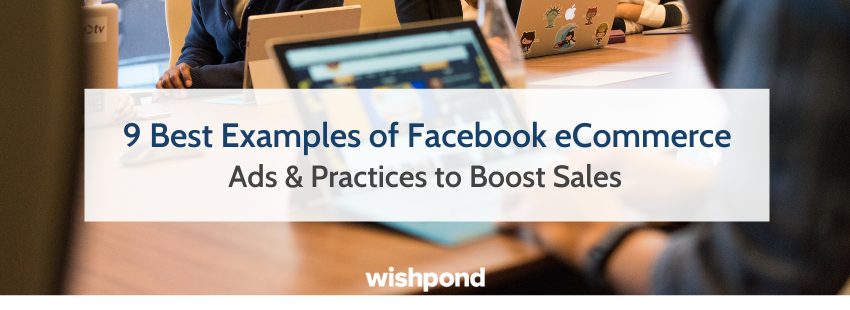
Over the years, Facebook ads have evolved with added features and tools to help eCommerce business owners. Next to optimizing your Facebook page, running eCommerce ads to help boost sales.
However, not all Facebook ads are built the same; some seem to do better than others, but why is that, shouldn't Facebook ads all do great?
Actually, it all boils down to how well your Facebook eCommerce ads are crafted. Almost 62% of marketers say that Facebook is a 'pay to play' platform and ends up missing their target market. That's not necessarily true.
You'll simply have to avoid simple Facebook ad mistake and follow the best practices to work alongside your budget.
Our Wishpond team has seen their fair share of the good, the bad, and the ugly examples of Facebook eCommerce ads, so today, we'll share the 12 best examples of Facebook eCommerce ads and practices we know will help you to boost sales.
Ready to dive in?
1. Use the Interests Field to Target High-Value Customers
When you're crafting a high converting Facebook eCommerce ad, you have to make sure you're putting your ad in front of the right people. Being too general when defining your audience can feel like shouting into a void.
Facebook allows you to target people based on the following:
- Interests and Brands: pages, events, business users follow (e.g., target people who like "Facebook Business page").
- Life events and some profile status: e.g. people who are recently engaged or have children.
- Age and gender
- People at a specific location: from an entire continent down to a 1-mile radius.
- Language: People who speak a certain language.
- Lookalike Audiences: Lookalike audiences are a very useful type of targeting where you can request Facebook to serve ads to people who are similar to an audience you provide.
Start by getting specific about the interest and demographic out to target with your Facebook eCommerce ads. If you're not sure how specific you can get with your audience or their attention, then it's time to create a buyer persona.
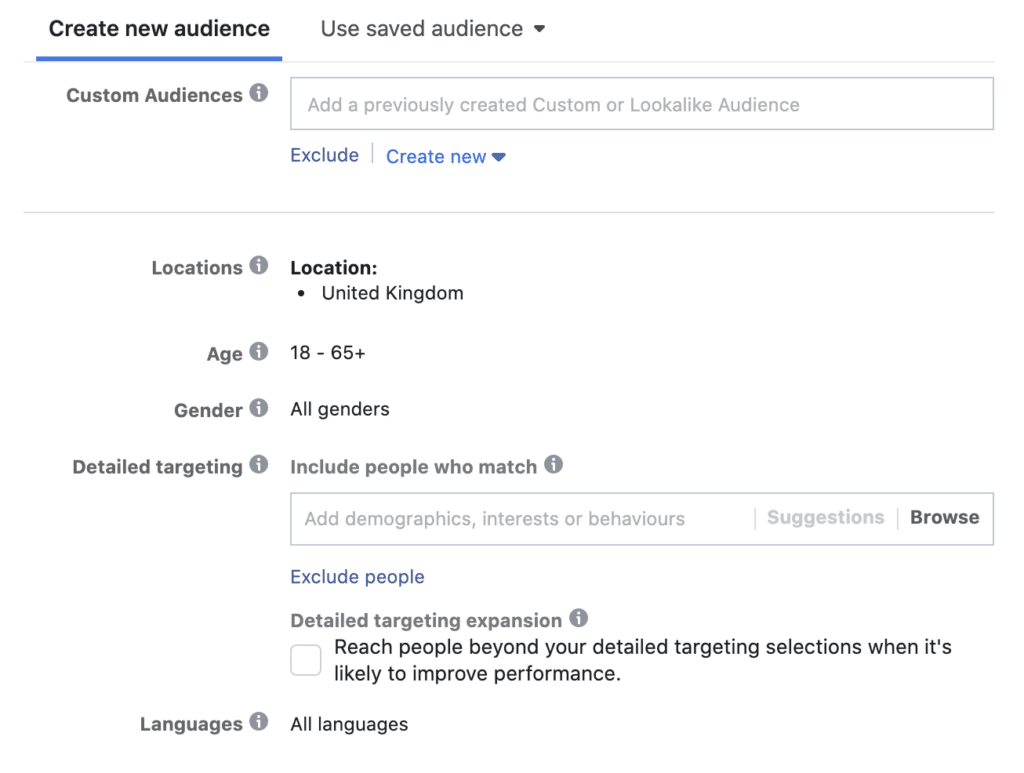
Maybe you have two target audiences, for example, you sell to both B2B and B2C. This means you'll have to craft two Facebook ads, one for your B2C target audience and one for your B2B audience. This allows you to reach both your target audience where they are, instead of bundling them together.
For more check out our guide on How to do Basic Facebook Ads Audience Targeting For Your Niche
2. Use Stunning Product Images in Your Ads
They say never judge a book by its cover. But when you look at these sunglass ad examples below, which one would you click? The one of the left!
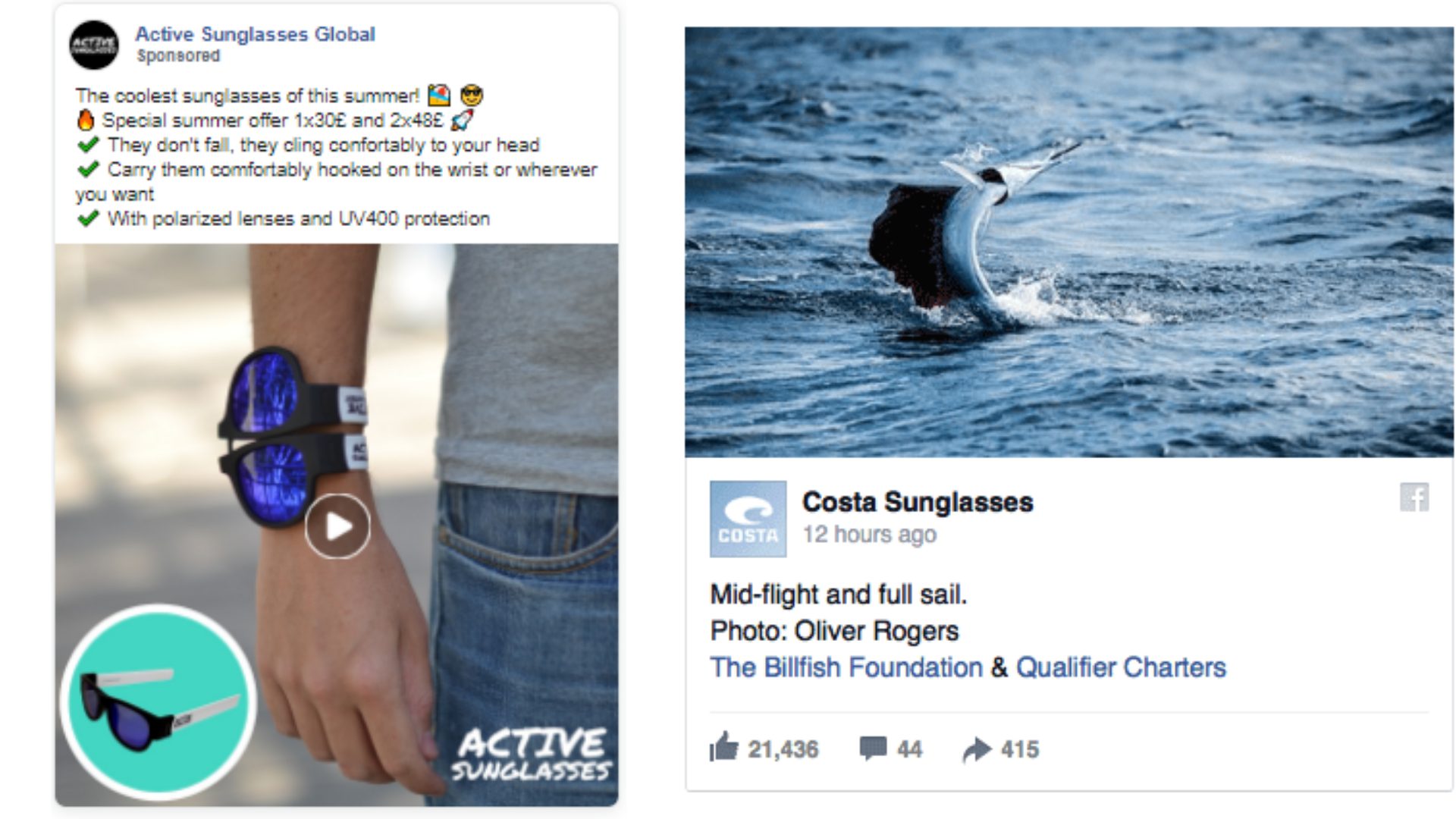
Simply because you do judge ads based on their product images. The images you use are just as important as the text, and CTA potential customers see when they look at your Facebook eCommerce ad.
Humans are visual creatures. They need to see your products at their best. Since most online shoppers can't touch or hold products before they buy them, they rely on professional and stunning images to win them over.
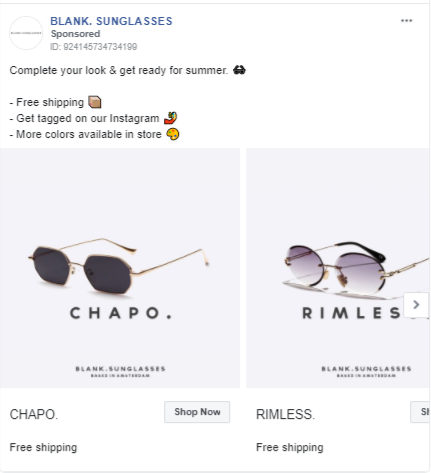
3 Top Tips When Using Product Images for Your Facebook Ads
-
Lighting is key: Dark, grainy or unflattering light makes your product look unflattering. On the other hand, too much light can be overexposing and can hide details from buyers.
-
Show Products from various angles: Choose an angle that shows buyers the full details of your product and gives them an idea of how the product looks in real life.
-
Use white or neutral backgrounds: If you're not using lifestyle backgrounds (products in kitchens, bathrooms, etc.), the next best thing is to use a background that keeps the product focused on white or neutral backdrops.
For more helpful tips check out these 6 Facebook Ad Image Best Practices that will Send your Click-Through-Rate to the Moon
3. Add Facebook Pixel for Your Website for Retargeting
Have you ever gone on a website, and for whatever reason you had to leave, maybe your boss walked in, or you had to answer an email? A few hours later, while you're scrolling through Facebook, you see an ad for the same website you left, that's a retargeting ad.
J.Crew Website

J.Crew Facebook Ads
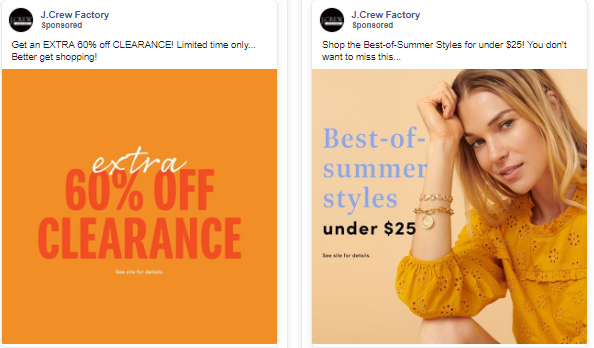
Retargeting ads are one of the best Facebook eCommerce ad practices around. It helps you to target potential eCommerce shoppers who left your website without completing a purchase.
Retargeting isn't just a plug and plays feature. There's a lot that goes into it. To help you along the way here are some detailed Facebook retargeting guides:
- How to Use Facebook Ads to Get Business Leads
- How to Use the Facebook Ad Conversion Pixel to Track Ecommerce Checkouts
Now that you know the power of Facebook Pixels, you should also consider tracking your conversion rates. Adding your Facebook Pixel is also crucial when it comes to your Facebook Ad Conversion Tracking.
Adding Facebook Pixels along with Google Analytics gives you powerful insight into what's working and what's not—allowing you to get the most out of your Facebook ads and adjust for more sales.
Need help with your next Facebook ad?
Book a free call to learn how our team of marketing experts can help you create high converting Facebook ads today.
4. Spend Time on Your Ad Copy and Call-To-Action
Your ad copy is the description you write in the caption for your Facebook eCommerce ad. Images are important in Facebook Ads, but copywriting is also essential. Once you've grabbed your viewer's attention with great visuals, it's time to let the copy speak.
Good copy or call to action can persuade your reader to click through to your website. It acts as a guide or sales pitch showing off your value proposition: how your brand can solve the reader's problems and why you're the best to do it.
Take a look at these examples below. Each Facebook ad sells a different item, however, each copy is utilized to sell the item at hand:
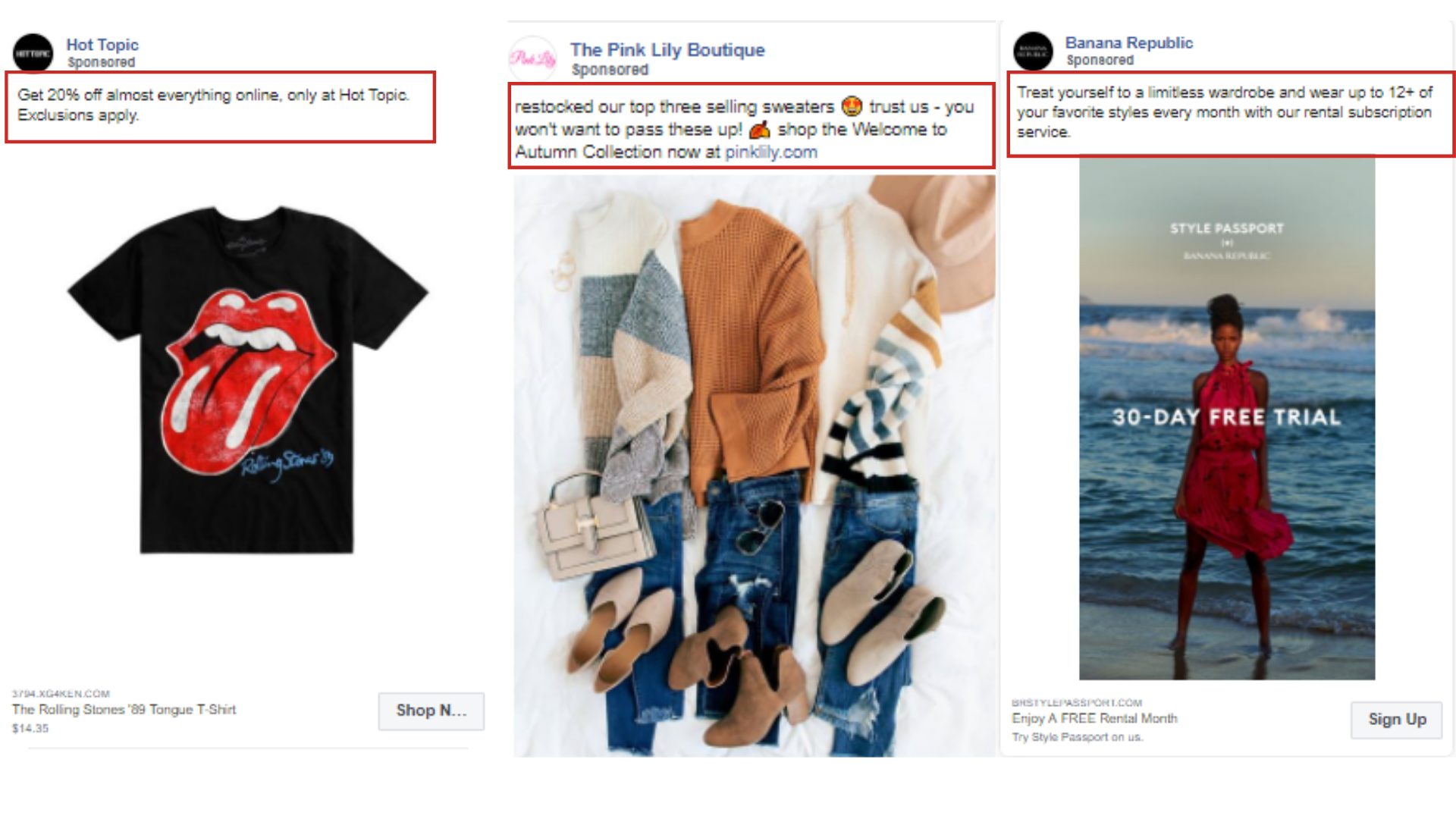
3 Tips When Writing Great Facebook ad Copy
1. Write for Your Audience, Not Yourself: When you're writing your Facebook ad copy, you should ensure it appeals to your buyer, not copy that crosses off your sales list. If it doesn't speak to their needs and wants, then they'll ignore your ad.
2. Stay Focused with One Call-to-Action It might be tempting to jam-pack your ad copy with as many call to actions as possible, but that will only confuse your readers. Keep it simple, stay focused on a singular call to action in your caption, or singular goal.
3. Keep it Short and Lead with Value: Avoid writing paragraphs in your ad copy. People have small attention spans, and even smaller attention spans when it comes to reading captions. Once you've grabbed your reader's attention with your visuals, seal the deal with a quick and informative caption.
The Psychology Behind a Successful Facebook Ad Part 3: Text
5. Ultize Facebook's Multiple Versions and Split Testing
Creating multiple versions or split testing is called A/B testing. A/B testing is done when you create multiple versions of your Facebook eCommerce ad to test against each other. In each variation, you make only one variable of the Ad different.
So if you're A/B testing your Facebook ad, use a different image, copy or CTA (call to action) one in each variation, but leave the image and description of the Facebook ads the same for both variations. This way, you will know for sure that it is the Headline that is causing the ad's conversion rate and nothing else.
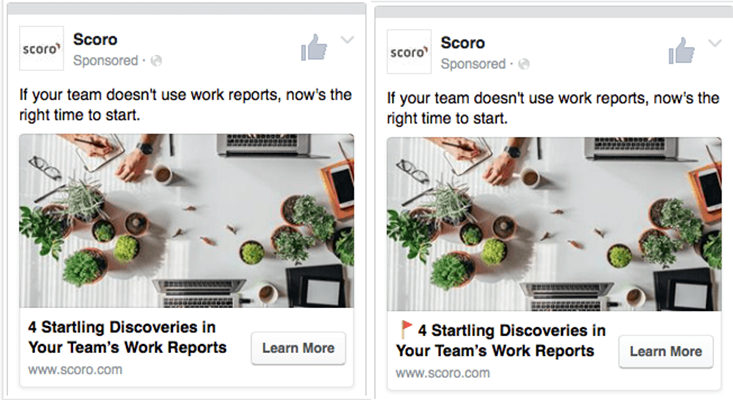
For more, check out How Facebook Ads A/B Testing is Done to Maximize Ad Performance
6. Use Video Demonstrations to Boost Sales
Video marketing has become a key factor in any ad or marketing strategy. Wistia found that on average, people spend 2.6x more time on pages with video than ads without video. So you get more attention with videos than you do with stats images.
Not to mention 64% of consumers will make a purchase after watching branded videos on social platforms, and 73% of B2B marketers say video positively impacts their ROI.
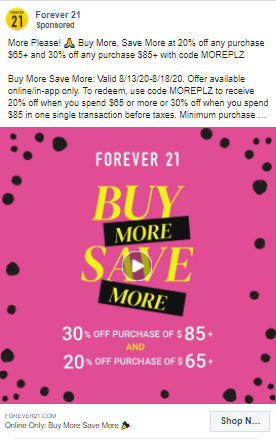
3 Tips When Adding Video to Your Facebook eCommerce Ads
1. Ensure Your Video Can Be Watched Without Sound: Around 85% of Facebook videos are watched without sound. Since Facebook gives it's users the option to turn off video sound, you need to consider making your video ads comprehensive with or without a sound present.
2. Keep Your Video Short: Once again, you need to ensure that your video is short and sweet. Ad Age found that only 33% of viewers will stop watching a video after 30 seconds, 45% by one minute, and 60% by two minutes. So keep your Facebook ads to 30-40 seconds or less.
3. Be Creative and Out of the Box: No one wants to watch an annoying Facebook ad of your products, video ads are made to get people excited about your offer. Be sure to come up with creative or colorful video ad ideas to grab your viewer's attention.
7. Utilize Facebook's Mobile Ads Feature
Everyone uses their phone, so much so that 94% of Facebook ad revenue is from mobile. Another great eCommerce ad practice is making sure your Facebook eCommerce ad is mobile friendly.
You hear marketers say "make your ads mobile-friendly," well, that's because a mere 6% of Facebook's advertising revenue comes from desktop-only users.
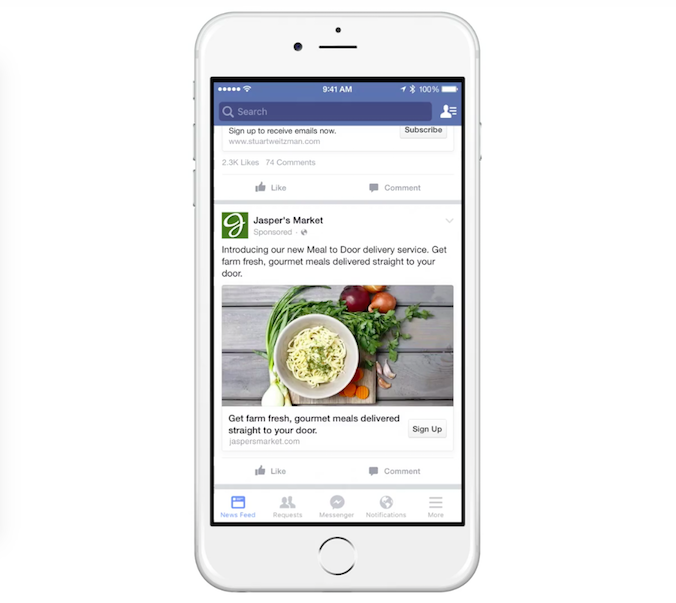
For more check out Word Stream's Beginner's Guide to Facebook Ads for Mobile Apps.
8. Boost Post with the Highest Engagement
Facebook has gone on record to say that organic reach for posts from businesses is decline. Facebook's goal here is to fill news feeds with content from friends and family, rather than brands. Facebook boosted posts are your chance to overcome that shift.
Hootsuite found that while your brand's organic content can deepen your relationship with your audience, Facebook ads remain the best way to expand your brand awareness to the 2.4 billion potential customers who use Facebook.
Every now and then, when you see a post doing particularly well organically on your feed Facebook gives you the option to "boost" this post. Now boosting your post and creating a Facebook ad campaign are two different things.
Promoting your post is just a short and less detailed version. While creating an ad campaign provides more reach to a detailed target audience. It shouldn't be used as a substitute for Facebook ad campaigns but rather a helpful boost in your eCommerce brand and product awareness.
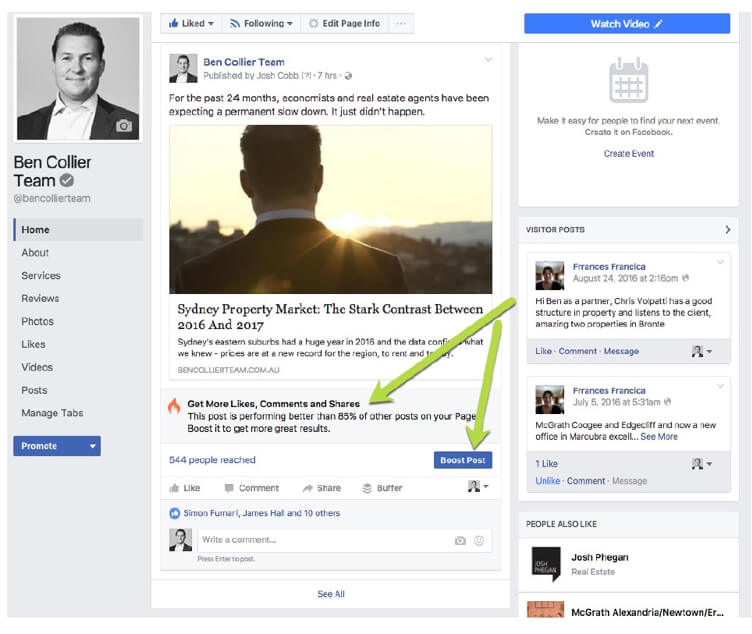
Start boosting your Facebook post with Wishpond's guide on How to Use Facebook Promoted Posts
9. Use Specific Landing Page for Your Facebook Ads
Most eCommerce owners make a rookie mistake is to link to their website rather than a specific landing page on their site or a lead generating landing page.
When you use your website link rather than a specific page, you leave your potential buyer to wonder your store, leave or search for the product from the ad that influenced them to click "Shop Now" in the first place. Instead, send them where you want them, and keep them there.
If you're hosting an offer, create a landing page to collect leads and push sales. When you're crafting a landing page for your Facebook eCommerce ad, ask yourself: What do you want to get from the visitors? What would you want them to do upon landing on that page?
From there, you can decide how and where your landing page should be. You can also A/B test your landing page to see which works best to fight Facebook Ad Fatigue.
Try the Most Powerful Landing Page Builder on Planet Earth
With Wishpond, you can choose from beautiful templates and lead generation tools to get the most out of your Facebook ad. Not to mention, you can publish your campaigns using four built-in options. Choose to publish your campaign on a custom domain, wishpond subdomain, embedded, or in a Facebook tab.
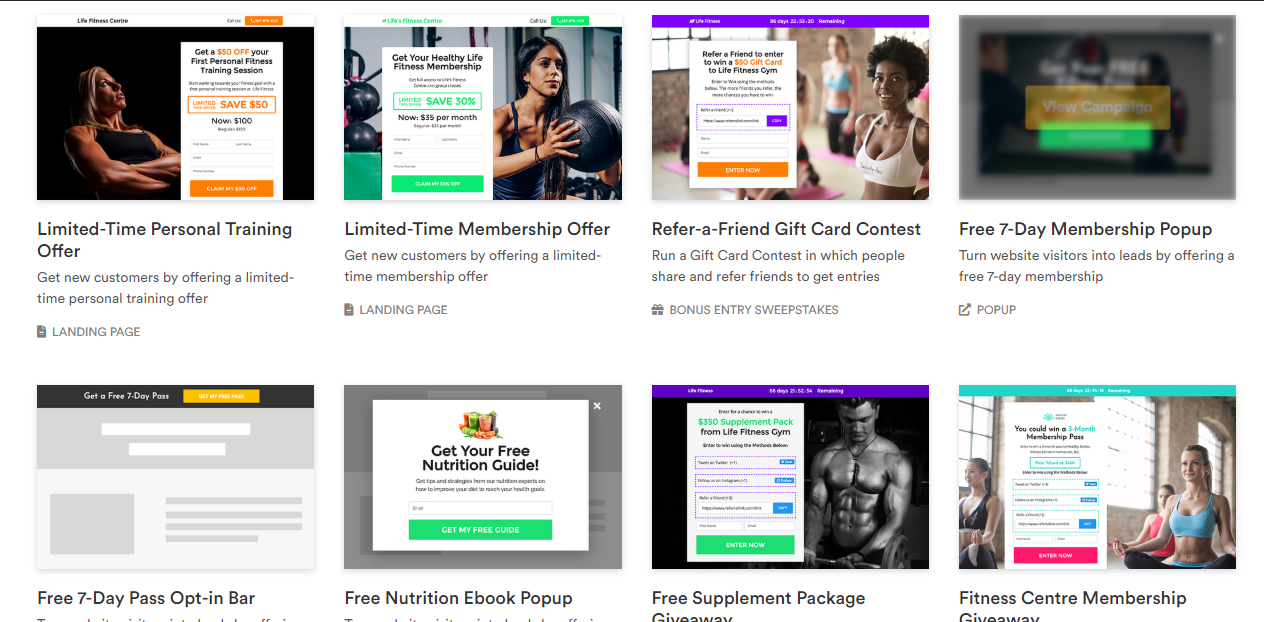
Our mission is to give marketers and business owners the easiest experience creating the highest quality landing pages on the market.
If you've ever dabbled in creating your own pages in the past, this is one editor you won't want to miss.
Summary
Using Facebook ads to increase eCommerce sales is always a smart move. When you're creating your ads, it's important to follow these tips and evaluate your past and current ads to get high conversions.
At Wishpond, we've helped businesses to generate over 100,000 leads; brands like SHOC have made over $45,000 in sales with the help of Wishpond's tools and team.
Ready to take your business Facebook ad campaigns to the next level?
Book a FREE call with one of our marketing experts today and see what Wishpond can do for you!
Related Articles
- 7 Amazing Ways Facebook Stories Can Increase Engagement & Sales
- 8 Stunning Facebook Ad Ideas Your Book Readers Will Love
- How to Run a Facebook Caption Contest (Step-by-Step Guide)
- 7 Facebook Ad Call-To-Action (CTA) Tips, Techniques & Best Practices
- Facebook Advertising Costs: CPC, CPM, CPA & CPL Guide
- Facebook Ads vs Google Adwords: The Facebook Ad Targeting Advantage
- The Complete Guide to Facebook Ads (Ebook)
from Wishpond https://ift.tt/2Zklf5b
via IFTTT

Comments
Post a Comment